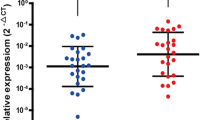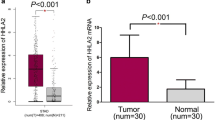Abstract
Background
Human four-and-a-half LIM domains 1 (Fhl1) gene has been reported to achieve cancer suppressive effects. The purpose of this study is to clarify clinical significance of Fhl1 expression in gastric cancer.
Methods
Fhl1 mRNA expression was quantified by real-time reverse transcription (RT)-polymerase chain reaction (PCR) using paired tumor and normal clinical samples from a total of 110 gastric cancer patients. Fhl1 protein expression was investigated by immunohistochemistry. The relationship between Fhl1 mRNA expression and clinicopathological factors was statistically analyzed.
Results
Fhl1 mRNA expression in tumor tissue was significantly downregulated compared with that in normal mucosa (P < 0.0001). Fhl1 protein expression was also diminished in cancer cells by immunohistochemistry. Kaplan–Meier survival curves demonstrated that the patients with low Fhl1 expression tumor showed significantly shorter survival (P < 0.05) than those with high Fhl1 expression tumor. Furthermore, the tumors with low Fhl1 expression showed deeper invasion into the serosal layer (P < 0.05) or more frequent distant metastasis (P < 0.01).
Conclusion
Fhl1 gene was underexpressed in clinical gastric cancer. Loss of Fhl1 expression would be a novel biomarker to determine biological aggressiveness of gastric cancer.



Similar content being viewed by others
References
Roder DM. The epidemiology of gastric cancer. Gastric Cancer 2002; 5:5–11.
Alberts SR, Cervantes A, van de Velde CJ. Gastric cancer: epidemiology, pathology and treatment. Ann Oncol 2003; 14:31–6.
Jemal A, Tiwari RC, Murray T, et al. Cancer Statistics, 2004. CA Cancer J Clin 2004; 54:8–29.
Mori M, Mimori K, Yoshikawa Y, et al. Analysis of the gene-expression profile regarding the progression of human gastric carcinoma. Surgery 2002; 131:S39–47.
Hashimoto Y, Shimada Y, Kawamura J, et al. The prognostic relevance of Fascin expression in human gastric carcinoma. Oncology 2004; 67:262–70.
Partin AW, Schoeniger JS, Mohler JL, et al. Fourier analysis of cell motility: Correlation of motility with metastatic potential. Proc Natl Acad Sci USA 1989; 86:1254–8.
Liotta LA, Kohn EC. The microenvironment of the tumor-host interface. Nature 2001; 411:375–9.
Ramaswamy S, Ross KN, Lander ES, et al. A molecular signature of metastasis in primary solid tumors. Nat Genet 2003; 33:49–54.
Oku N, Sasabe E, Ueta E, et al. Tight junction protein claudin-1 enhances the invasive activity of oral squamous cell carcinoma cells by promoting cleavage of laminin-5 γ2 chain via matrix metalloproteinase (MMP)-2 and membrane-type MMP-1. Cancer Res 2006; 66:5251–7.
Johannessen M, Møller S, Hansen T, et al. The multifunctional roles of the four-and-a-half-LIM only protein FHL2. Cell Mol Life Sci 2006; 63:268–84.
Morgan MJ, Madgwick AJ, Charleston B, et al. The developmental regulation of a novel muscle LIM-protein. Biochem Biophys Res Commun 1995; 212:840–6.
Brown S, McGrath MJ, Ooms LM, et al. Characterization of two isoforms of the skeletal muscle LIM protein 1, SLIM1. J Biol Chem 1999; 274:27083–9.
Shen Y, Jia Z, Nagele RG, et al. Src uses Cas to suppress Fhl1 in order to promote nonanchored growth and migration of tumor cells. Cancer Res 2006; 66:1543–52.
Bhattacharjee A, Richards WG, Staunton J, et al. Classification of human lung carcinomas by mRNA expression profiling reveals distinct adenocarcinoma subclasses. Proc Natl Acad Sci USA 2001; 98:13790–5.
Finley DJ, Arora N, Zhu B, et al. Molecular profiling distinguishes papillary carcinoma from benign thyroid nodules. J Clin Endocrinol Metab 2004; 89:3214–23.
Fryknäs M, Wickenberg-Bolin U, Göransson H, et al. Molecular markers for discrimination of benign and malignant follicular thyroid tumors. Tumor Biol 2006; 27:211–20.
Japanese Gastric Cancer Association: Japanese classification of gastric cancer, 2nd English Edition. Gastric Cancer 1998; 1:10–24
Jass JR, Sobin LH, Watanabe H. The World Health Organization’s histologic classification of gastrointestinal tumors. A commentary on the second edition. Cancer 1990; 66:2162–7.
Lauren P. The two histological main types of gastric carcinoma. Diffuse and so-called intestinal type carcinoma. An attempt at histoclinical classification. Acta Pathol Microbio Scand 1965; 64:31–49.
Ohmachi T, Tanaka F, Mimori K, et al. Clinical significance of TROP2 expression in colorectal cancer. Clin Cancer Res 2006; 12:3057–63.
Ogawa K, Utsunomiya T, Mimori K, et al. Clinical significance of human kallikrein gene 6 messenger RNA expression in colorectal cancer. Clin Cancer Res 2005; 11:2889–93.
Sasaki A, Iwashita Y, Shibata K, et al. Improved long-term survival after liver resection for hepatocellular carcinoma in the modern era: Retrospective study from HCV-endemic areas. World J Surg 2006; 30:1567–78.
Yang S, Shin J, Park KH, et al. Molecular basis of the differences between normal and tumor tissue of gastric cancer. Biochimica et Biophysica Acta 2007; 1772:1033–40.
Brábek J, Constancio SS, Shin NY, et al. CAS promotes invasiveness of Src-transformed cells. Oncogene 2004; 23:7406–15.
Shin NY, Dise RS, Schneider-Mergener J, et al. Subsets of the major tyrosine phosphorylation sites in Crk-associated substrate (CAS) are sufficient to promote cell migration. J Biol Chem 2004; 279:38331–7.
Goldberg GS, Alexander DB, Pellicena P, et al. Src phosphorylates Cas on tyrosine 253 to promote migration of transformed cells. J Biol Chem 2003; 278:46533–40.
Mayer B, Johnson JP, Leitl F, et al. E-cadherin expression in primary and metastatic gastric cancer: down-regulation correlates with cellular dedifferentiation and glandular disintegration. Cancer Res 1993; 53:1690–5.
Wang J, Yang Y, Xia HHX, et al. Suppression of FHL2 expression induces cell differentiation and inhibits gastric and colon carcinogenesis. Gastroenterology 2007; 132:1066–76.
Ng EKO, Lee SMY, Li H-Y, et al. Characterization of tissue-specific LIM domain protein (FHL1C) which is an alternatively spliced isoform of a human LIM-only protein (FHL1). J Cell Biochem 2001; 82:1–10.
Grossi M, Hiou-Feige A, Di Vignano AT, et al. Negative control of keratinocyte differentiation by Rho/CRIK signaling coupled with up-regulation of KyoT1/2 (FHL1) expression. Proc Natl Acad Sci USA 2005; 102:11313–8.
LaTulippe E, Satagopan J, Smith A, et al. Comprehensive gene expression analysis of prostate cancer reveals distinct transcriptional programs associated with metastatic disease. Cancer Res 2002; 62:4499–506.
Dai N, Bao Q, Lu A, et al. Protein of Osteopontin in tumor tissues is an independent prognostic indicator in gastric cancer. Oncology 2007; 72:89–96.
Sakamoto Y, Sano T, Shimada K, et al. Favorable indications for hepatectomy in patients with liver metastasis from gastric cancer. J Surg Oncol 2007; 95:534–9.
Acknowledgments
We thank T. Shimooka, K. Ogata, M. Oda, N. Kasagi, and Y. Nakagawa for their excellent technical assistance. This work was supported in part by the following grants and foundations: CREST, Japan Science and Technology Agency (JST); Japan Society for the Promotion of Science (JSPS), Grant-in-Aid for Scientific Research, grant numbers 17109013, 17591411, 17591413, 18390367, 18590333, 18659384, and 18790964; The Ministry of Education, Culture, Sports, Science and Technology (MEXT) Grant-in-Aid for Scientific Research on Priority Area, grant number 18015039.
Author information
Authors and Affiliations
Corresponding author
Rights and permissions
About this article
Cite this article
Sakashita, K., Mimori, K., Tanaka, F. et al. Clinical Significance of Loss of Fhl1 Expression in Human Gastric Cancer. Ann Surg Oncol 15, 2293–2300 (2008). https://doi.org/10.1245/s10434-008-9904-3
Received:
Revised:
Accepted:
Published:
Issue Date:
DOI: https://doi.org/10.1245/s10434-008-9904-3




